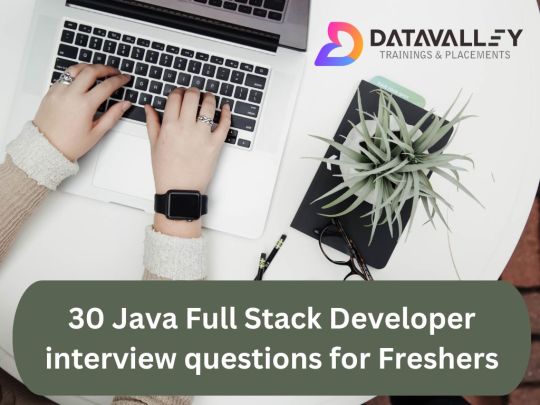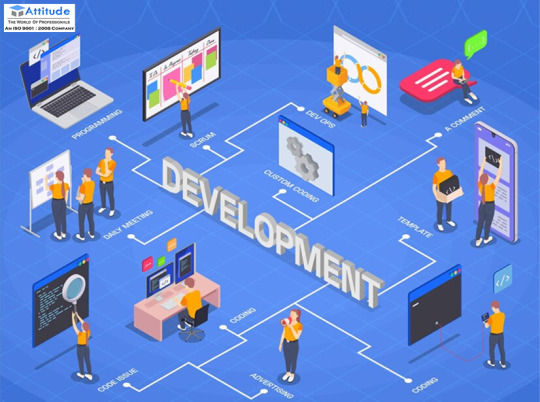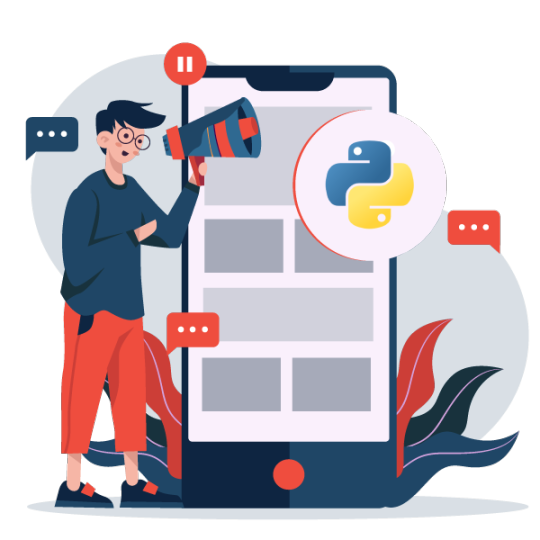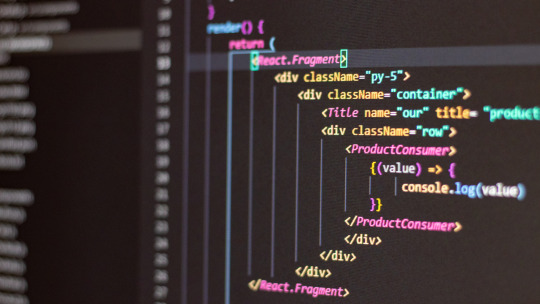#full stack devlopement
Explore tagged Tumblr posts
Text
30 Java Full Stack Developer interview questions for Freshers

Are you an aspiring programmer seeking to start a professional journey as a Java Full Stack Developer? As you venture into the realm of web and software development, it is essential to equip yourself with the necessary skills and knowledge to effectively tackle the forthcoming challenges. Getting your first job as a Full Stack Developer is a big achievement, and to assist you, we have created a list of 30 Java Full Stack Developer interview questions specifically designed for beginners.
1. What is Java Full Stack Development?
Java Full Stack Development refers to the development of web applications using both front-end and back-end technologies, with Java as the primary programming language.
2. Explain the difference between front-end and back-end development.
Front-end development focuses on the user interface and client-side functionality, while back-end development deals with server-side logic and database interactions.
3. What are the key components of a typical web application stack?
A typical web application stack consists of a front-end framework (e.g., React, Angular), a back-end server (e.g., Spring Boot), and a database (e.g., MySQL).
4. What is Java Virtual Machine (JVM) and why is it important in Java development?
JVM is an essential part of Java that interprets Java bytecode and allows cross-platform compatibility. It plays a crucial role in running Java applications.
5. What is a servlet, and how does it relate to Java web development?
A servlet is a Java class used to extend the capabilities of servers and provide dynamic content. It is commonly used in Java web development to handle HTTP requests and responses.
6. Explain the Model-View-Controller (MVC) architectural pattern.
MVC is an architectural pattern that separates an application into three interconnected components: Model (data), View (user interface), and Controller (handles user input and updates the model and view).
7. What is Spring Framework, and how does it simplify Java development?
Spring is a popular Java framework that simplifies Java development by providing features like dependency injection, AOP, and MVC for building scalable and maintainable applications.
8. Describe RESTful web services and their importance in Java development.
RESTful web services are a way to build lightweight and scalable APIs using HTTP methods. They are essential for building modern web applications in Java.
9. What is Hibernate, and how does it relate to database interaction in Java?
Hibernate is an ORM (Object-Relational Mapping) framework that simplifies database interaction in Java by mapping Java objects to database tables.
10. Explain the concept of dependency injection in Spring.
Dependency injection is a design pattern used in Spring to manage component dependencies. It allows for loosely coupled and easily testable code by injecting dependencies rather than creating them.
11. What is a singleton pattern, and why is it relevant in Java development?
The singleton pattern ensures that a class has only one instance and provides a global point of access to that instance. It’s used to manage resources like database connections efficiently.
12. What is the difference between GET and POST HTTP methods?
GET is used for retrieving data from the server, while POST is used for sending data to the server for processing or storage.
13. What is SQL injection, and how can it be prevented in Java applications?
SQL injection is a security vulnerability where malicious SQL code is injected into user inputs. To prevent it, use parameterized queries and input validation.
14. Explain the purpose of a web container in Java EE applications.
A web container is responsible for managing the lifecycle of servlets and JSP pages in Java EE applications. (e.g., Tomcat)
15. What is a session in web applications, and how is it managed in Java?
A session is a mechanism to maintain user-specific data across multiple HTTP requests. In Java, sessions can be managed using cookies or URL rewriting.
16. What is the difference between forward and sendRedirect in servlets?
forward is used to forward the request and response objects to another resource within the same server, while sendRedirect sends a response with a new URL, causing a new request.
17. Explain the purpose of the @RequestMapping annotation in Spring MVC.
@RequestMapping is used to map a URL request to a specific controller method in Spring MVC, allowing for proper routing of requests.
18. What is a RESTful API endpoint, and how is it structured?
A RESTful API endpoint is a URL pattern that represents a resource and its actions. It typically follows a structured format, such as /resource/{id}.
19. What is CORS, and why is it important in web development?
CORS (Cross-Origin Resource Sharing) is a security feature that allows or restricts web pages in one domain from making requests to a different domain. It’s essential for security in web development.
20. What is the purpose of the web.xml file in Java web applications?
The web.xml file is a configuration file in Java web applications that defines servlets, filters, and their mappings, among other things.
21. Explain the concept of microservices and their advantages.
Microservices is an architectural style where an application is composed of small, independently deployable services. Advantages include scalability, maintainability, and flexibility.
22. What is Docker, and how does it facilitate deployment in Java development?
Docker is a containerization platform that allows developers to package applications and their dependencies into containers for consistent and efficient deployment.
23. What is the purpose of a version control system like Git in software development?
Git is used for tracking changes in code, collaborating with others, and maintaining a history of code revisions, which is essential for code management and collaboration.
24. How does Maven help in managing project dependencies in Java?
Maven is a build automation tool that simplifies the process of managing project dependencies, building projects, and producing artifacts.
25. What is the purpose of JUnit in Java development, and how is it used for testing?
JUnit is a testing framework used for writing and executing unit tests in Java. It ensures that individual components of the code function correctly.
26. Explain the concept of continuous integration (CI) and continuous delivery (CD).
CI involves regularly merging code changes into a shared repository, while CD automates the process of deploying code changes to production, ensuring a streamlined development workflow.
27. What is the Spring Boot framework, and how does it simplify Java application development?
Spring Boot is a framework that simplifies the setup and configuration of Spring applications, allowing developers to quickly build production-ready applications with minimal effort.
28. What are the key principles of the SOLID design principles in Java development?
SOLID is an acronym representing five design principles: Single Responsibility, Open/Closed, Liskov Substitution, Interface Segregation, and Dependency Inversion. These principles promote clean and maintainable code.
29. What is the purpose of the @Autowired annotation in Spring?
@Autowired is used for automatic dependency injection in Spring, allowing Spring to automatically resolve and inject dependencies into a class.
30. How can you secure a Java web application against common security threats?
Secure a Java web application by implementing proper authentication, authorization, input validation, using encryption, and regularly updating dependencies to patch vulnerabilities.
#datavalley#dataexperts#data engineering#data analytics#dataexcellence#business intelligence#data science#power bi#data analytics course#data science course#java#java full stack developer#java interview questions#java full stack course#java full stack training#full stack devlopement
0 notes
Text

Digital marketing traning in gurgaon .
0 notes
Text
What Challenges Do Full Stack Developers Typically Face?

In the dynamic realm of web and software development, full stack developers play the role of digital polymaths. They possess the rare ability to handle both front-end and back-end tasks, but this versatile role comes with its own share of hurdles. In this article, we will explore the challenges that full stack developers commonly encounter, paying particular attention to the intricacies of this demanding yet rewarding role.
Front-End Development Challenges:
Front-end development revolves around crafting user interfaces and ensuring a seamless user experience. Here are some of the common challenges faced by full stack developers in the front-end:
User Interface (UI) and User Experience (UX) Design: Creating an engaging and user-friendly interface that caters to diverse user preferences and devices can be a complex endeavor. Developers must stay abreast of design trends and best practices to keep interfaces fresh and functional.
Cross-Browser Compatibility: Ensuring that a website or application appears and functions consistently across different web browsers is a formidable challenge. Browsers often interpret code differently, demanding developers to craft code that harmonizes with the entire browser spectrum.
Performance Optimization: Achieving optimal loading times and seamless interactions is paramount. Front-end developers need to adeptly compress images, minimize HTTP requests, and optimize code to deliver the finest user experience.
Responsive Design: In the era of mobile devices, creating responsive designs that adapt to varying screen sizes is a foundational challenge. Guaranteeing an equally stellar user experience on a desktop computer and a smartphone is no small feat.
Accessibility: Creating an inclusive digital environment is a fundamental requirement. Developers must adhere to web accessibility standards to ensure that all users, including those with disabilities, can navigate and utilize the application or website.
Back-End Development Challenges:
Back-end development is responsible for server-side logic, databases, and overall application functionality. Here are some of the challenges that full stack developers face on the back end:
Scalability: As applications grow and attract more users, scalability emerges as a critical concern. Back-end developers must design systems that can gracefully handle increased traffic and data without compromising performance.
Security: Safeguarding sensitive user data and preventing security breaches is a top priority. Developers need to implement robust security measures, such as encryption and authentication, to fortify the application against threats.
Database Management: Efficiently storing and retrieving data is a complex task. Developers must work with databases, ensuring data integrity and fine-tuning queries for enhanced performance.
Server Maintenance: Keeping servers operational demands constant vigilance and maintenance. Any downtime can lead to user and revenue loss, making server management a challenging and critical aspect of back-end development.
API Integration: Many applications depend on third-party APIs for various functions. Full stack developers must seamlessly integrate these APIs, ensuring data consistency and reliability.
Code Optimization: Crafting efficient, clean, and maintainable code is an ongoing challenge. Minimizing code bloat is essential, making the application more manageable and scalable.
Conclusion:
Full stack developers wear multiple hats, juggling an array of responsibilities from front-end design to back-end server management. They encounter a unique set of challenges in each domain. By embracing these challenges and continually refining their skills, full stack development can craft robust, user-friendly, and secure applications that meet the ever-evolving demands of the digital world.
#full stack devlopment#full stack development course in yamuna vihar#full stack course#full stack training#full stack web development#full stack developer#attitude academy#enrollnow#learnwithattitudeacademy#bestcourse#attitude tally academy
0 notes
Text
Are you looking for experienced front-end development?
Our experienced full-stack web development team is here to help! We specialize in creating high-performance websites that drive results. From stunning design to seamless functionality, we've got you covered. Let us enhance your digital presence and grow your business. Contact us today for the best web development services. For more details call Ansumiti Technosoft at +91-8595818014.
#full stack web devlopment#front end devlopment#web devlopment firms#web devlopment companies#php devlopment
0 notes
Text
Full-Stack Web Development In 7 days Ebook
1 note
·
View note
Text
website devloper
A website developer is a professional who builds and maintains websites. They ensure websites are functional, user-friendly, and optimized for performance. There are three main types of web developers:
1. Front-End Developer
✅ Works on the visual part of the website (what users see). ✅ Uses HTML, CSS, JavaScript and frameworks like React, Vue, or Angular. ✅ Focuses on responsive design, animations, and user experience (UX/UI).
2. Back-End Developer
✅ Handles the server-side logic and database of a website. ✅ Works with Node.js, PHP, Python, Ruby, or Java to manage data and processing. ✅ Uses databases like MySQL, PostgreSQL, and MongoDB to store and retrieve data.
3. Full-Stack Developer
✅ Can do both front-end and back-end development. ✅ Builds complete web applications, from UI to database management. ✅ Knows both front-end and back-end technologies, making them highly versatile.
Skills Required to Become a Website Developer
🔹 Programming Languages: HTML, CSS, JavaScript 🔹 Frameworks & Libraries: React, Angular, Vue, Bootstrap 🔹 Backend Technologies: Node.js, PHP, Python, Laravel 🔹 Databases: MySQL, MongoDB, Firebase 🔹 Version Control: Git, GitHub 🔹 Web Hosting & Deployment: Netlify, Vercel, AWS
0 notes
Text
🔥Go and Register now to become 001 in FULL Stack Devlopment Program 🔥 🎉OFFER🎉 🎊Duo-12k/person OFF🎊 🎊single-7k OFF🎊 This valentine's Day Bring Your Friends To Avail This Offer📞🎁 [For more information DM us or Call us on 9867629226]
#coding#webdevelopment#developer#techpaathshala#tech#tech updates#software#programming#fullstackdeveloper#cool tech#squid game#squid game meme
0 notes
Text
Se você é um profissional de TI buscando expandir suas habilidades e se destacar no mercado, o curso "Full Stack Web Development" oferecido pela Coursera é uma excelente escolha. 𝗘𝘀𝘁𝗲 𝗰𝘂𝗿𝘀𝗼 é 𝗶𝗱𝗲𝗮𝗹 𝗽𝗮𝗿𝗮 𝗾𝘂𝗲𝗺 𝗱𝗲𝘀𝗲𝗷𝗮 𝗱𝗼𝗺𝗶𝗻𝗮𝗿 𝗼 𝗱𝗲𝘀𝗲𝗻𝘃𝗼𝗹𝘃𝗶𝗺𝗲𝗻𝘁𝗼 𝘄𝗲𝗯 𝗱𝗲 𝗽𝗼𝗻𝘁𝗮 𝗮 𝗽𝗼𝗻𝘁𝗮, cobrindo tanto o front-end quanto o back-end. 💻🌐
𝗣𝗼𝗿 𝗾𝘂𝗲 𝗘𝘀𝗰𝗼𝗹𝗵𝗲𝗿 𝗘𝘀𝘁𝗲 𝗖𝘂𝗿𝘀𝗼? 🎯
𝘊𝘰𝘯𝘵𝘦ú𝘥𝘰 𝘈𝘣𝘳𝘢𝘯𝘨𝘦𝘯𝘵𝘦: O curso cobre uma ampla gama de tecnologias essenciais, incluindo HTML, CSS, JavaScript, Node.js, Express, MongoDB e React. Isso garante que você tenha uma compreensão completa do desenvolvimento web moderno. 📚
𝘐𝘯𝘴𝘵𝘳𝘶𝘵𝘰𝘳𝘦𝘴 𝘥𝘦 𝘙𝘦𝘯𝘰𝘮𝘦: Ministrado por professores da Universidade de Hong Kong, o curso oferece uma experiência de aprendizado de alta qualidade com profissionais experientes na área. 👨🏫👩🏫
𝘗𝘳𝘰𝘫𝘦𝘵𝘰𝘴 𝘗𝘳á𝘵𝘪𝘤𝘰𝘴: Ao longo do curso, você trabalhará em projetos práticos que ajudam a consolidar o conhecimento adquirido. Isso é fundamental para construir um portfólio sólido e demonstrar suas habilidades a empregadores potenciais. 🛠️
𝘍𝘭𝘦𝘹𝘪𝘣𝘪𝘭𝘪𝘥𝘢𝘥𝘦 𝘥𝘦 𝘈𝘱𝘳𝘦𝘯𝘥𝘪𝘻𝘢𝘥𝘰: Sendo um curso online, você pode aprender no seu próprio ritmo, ajustando o cronograma de estudos conforme sua disponibilidade. Isso é perfeito para profissionais que já estão no mercado de trabalho. ⏰
𝘊𝘦𝘳𝘵𝘪𝘧𝘪𝘤𝘢çã𝘰 𝘙𝘦𝘤𝘰𝘯𝘩𝘦𝘤𝘪𝘥𝘢: Ao concluir o curso, você receberá um certificado que pode ser adicionado ao seu LinkedIn ou currículo, aumentando sua visibilidade e credibilidade no mercado de trabalho. 📜
🔗𝘗𝘢𝘳𝘢 𝘮𝘢𝘪𝘴 𝘪𝘯𝘧𝘰𝘳𝘮𝘢çõ𝘦𝘴, 𝘯𝘰𝘴 𝘤𝘩𝘢𝘮𝘦 𝘯𝘰 𝘞𝘩𝘢𝘵𝘴𝘢𝘱𝘱 (11) 97305-3545
✨o𝘶 𝘷𝘪𝘴𝘪𝘵𝘦 𝘯𝘰𝘴𝘴𝘰 𝘚𝘪𝘵𝘦: 𝘳𝘦𝘤𝘳𝘶𝘵𝘦.𝘵𝘦𝘤𝘩
#tech #tecnologia #carreiratech #dev #devlops
0 notes
Text
Fullstack Devlopers
0 notes
Text
What Frameworks and Libraries Should I Learn for Full Stack Development?

Introduction
full-stack developer is proficient in both front-end and back-end technologies, enabling them to build complete web applications from start to finish. To excel in this field, you need to familiarize yourself with a variety of frameworks and libraries. learn Full-stack development is a versatile and in-demand skill in the tech industry. In this blog, we'll explore the essential tools you should learn to become a proficient full-stack developer.
Front-End Development
HTML, CSS, and JavaScript: These are the foundational technologies of web development. HTML structures the content, CSS styles it, and JavaScript adds interactivity. A solid grasp of these three is a must for any full-stack developer.
React (or Vue or Angular): Modern web applications often use a JavaScript library or framework for building interactive and dynamic user interfaces. React, Vue, and Angular are popular choices.
Redux (or Vuex or NgRx): To manage the state of your application, state management libraries like Redux (for React), Vuex (for Vue), or NgRx (for Angular) are essential.
Webpack (or Parcel or Rollup): Module bundlers like Webpack help you bundle and optimize your code for production.
Responsive Design: Learn how to make your applications look great on various devices and screen sizes using media queries and CSS frameworks like Bootstrap or Foundation.
Back-End Development
Node.js: Node.js is a JavaScript runtime that allows you to build server-side applications. It's commonly used with frameworks like Express.js.
Express.js (or Koa.js or Hapi.js): These are Node.js frameworks that simplify server-side development by providing routing, middleware, and other useful features.
Databases (SQL and NoSQL): Understanding both SQL databases (like MySQL, PostgreSQL) and NoSQL databases (like MongoDB, Cassandra) is important for handling data efficiently.
RESTful and GraphQL APIs: Learn how to create and consume RESTful APIs and GraphQL to interact with your server and databases.
Authentication and Authorization: Implement user authentication and authorization to secure your applications. Popular libraries include Passport.js and JSON Web Tokens (JWT).
Caching and Session Management: Tools like Redis can help you manage sessions and cache data for improved performance.
Web Server: Learn how to configure and manage web servers like Nginx or Apache to deploy your applications.
Tools for Both Front-End and Back-End
Git and GitHub: Version control is crucial for collaborating and managing your codebase. Git is the most popular version control system, and GitHub is a widely used platform for hosting and sharing code.
Docker: Containerization simplifies the deployment of applications across different environments, ensuring consistency and scalability.
Package Managers: NPM (for Node.js) and Yarn are essential for managing project dependencies.
Testing Frameworks: Tools like Jest, Mocha, and Chai are used for unit and integration testing.
Continuous Integration and Deployment (CI/CD): Learn how to automate the testing, building, and deployment processes using platforms like Jenkins, Travis CI, or GitLab CI/CD.
Conclusion
Full-stack development is a multifaceted skill that requires proficiency in various front-end and back-end technologies. By mastering the essential frameworks and libraries listed in this blog, you'll be well-equipped to build complete web applications and become a successful full-stack developer. Keep in mind that technology evolves, so continuous learning and adaptation are vital to staying competitive in this dynamic field. Good luck on your full-stack development journey!
#attitude academy#enrollnow#learnwithattitudeacademy#bestcourse#full stack devlopment#full stack development course in yamuna vihar#full stack training#attitude tally academy
0 notes
Photo

Hi! Mahadi H Ebrahim here. I'm a Full Stack Web Developer more than 2 years of experience. I have developed and design a wide range of websites. I build High-End Lucrative, Professional, Responsive and Eye-Catching websites from scratch OR Revamp any current website AND can fix bugs in any website. I have my excellent skills in WORDPRESS, PHP, JAVASCRIPT, BOOTSTRAP, HTML, CSS. Any kind website creation, E-commerce stores, Customization, Speed, SEO, & Security. My aim is to give my clients exactly what they need and guide them all through the procedure. My client's Success is my Success. I'm available with my best services 24/7. Spare a couple minutes to see my portfolio to get a thought of my designing and development abilities Lets connect and begin taking a shot at your fantasy site! Thank You
#web design#web development#full stack backend developer#full stack web development#web application design#web devlopers
2 notes
·
View notes
Text
0 notes
Text
𝗙𝘂𝗹𝗹 𝗦𝘁𝗮𝗰𝗸 𝗗𝗲𝘃𝗲𝗹𝗼𝗽𝗲𝗿 𝗠𝗮𝘀𝘁𝗲𝗿𝗰𝗹𝗮𝘀𝘀

𝐋𝐞𝐚𝐫𝐧 𝐅𝐮𝐥𝐥 𝐒𝐭𝐚𝐜𝐤 𝐃𝐞𝐯𝐞𝐥𝐨𝐩𝐞𝐫 𝐌𝐚𝐬𝐭𝐞𝐫 𝐂𝐥𝐚𝐬𝐬 𝐰𝐢𝐭𝐡 𝐢𝐧𝐝𝐮𝐬𝐭𝐫𝐲 𝐞𝐱𝐩𝐞𝐫𝐭 𝐣𝐨𝐢𝐧 𝗗𝗶𝗰𝘀 𝗟𝗮𝘅𝗺𝗶 𝗡𝗮𝗴𝗮𝗿 𝟭𝟬𝟬% 𝗽𝗹𝗮𝗰𝗲𝗺𝗲𝗻𝘁 𝗮𝗻𝗱 𝗮𝗰𝗮𝗱𝗲𝗺𝗶𝗰 𝘀𝘂𝗽𝗽𝗼𝗿𝘁 𝗧𝗼 𝗰𝗼𝗺𝗲 𝗝𝗼𝗶𝗻 𝗻𝗼𝘄 𝗳𝗼𝗿 𝗗𝗶𝗰𝘀 𝗹𝗮𝘅𝗺𝗶 𝗡𝗮𝗴𝗮𝗿.
#fullstackdeveloper#dics#education#institute#javascript#web devlopment#technology#full stack web development#coding#html
0 notes
Text
List of 7 FREE Best Apps To Learn Python On Android And IOS
For More Details about Python Check this link :Best Python Framework for Mobile App Development

Python is a very powerful and readable programming language, and learning Python can be of great use if you are looking to get into the development world or even just to beef up your resume. It’s also one of the easiest languages to learn, and there are plenty of free resources out there to help you master it. Here’s our list of the best free apps that will get you up to speed on Python devloping in no time!
1) Dataquest
This is a great platform to learn python as it has many courses starting from data exploration to building games using python. It provides a clean interface which makes it easy for beginners to use. The best part about Dataquest is that, its completely free. If you are looking for an app to start learning python with, then Dataquest would be my first recommendation.
2) Pythonista App
The Pythonista app for iOS is a coding playground for fans of Apple products who want to dip their toes into programming with python. With more than 100 custom-built functions, you can use Pythonista to control hardware like push notifications and Wi-Fi through an in-app purchase, or even conduct experiments with visible light and other electronics (assuming you have some background knowledge in that area). It’s a great way to learn programming by building on your own or alongside a tutor. The app requires iOS 8 or later, and costs $4.99. The developer maintains a detailed list of devices supported here .
3) PyCharm Edu
If you are planning to learn python and become a developer then you have landed at right place. Coder is one of most powerful android apps for learning python programming language. In addition to learning python in simple and interactive way with full examples and codes, coder also allows you to do practice test with flashcards, exercises and more fun features. If you love challenges then another cool feature of coder app is that it offers challenges which are difficult than problems listed in documents but helps in building logic when dealing with difficult problems by applying various methods used here in that particular challenge.
4) Coder
Coder is a FREE app that helps you learn to code. It teaches you real-world skills like web development, game development, and programming languages. Start with step-by-step guides that teach basic concepts, then move on to challenges that help you practice what you've learned. Coder comes with all kinds of tools—like code editors and virtual machines—that make it easy to learn your favorite language or program a game. Even better: it's totally FREE!
5) Termius Terminal
Termius is a feature-rich SSH client and terminal emulator. If you want to know how to control your remote machine via command line, Termius is an essential tool. The program gives you access to a built-in text editor, clipboard history (via keyboard shortcuts) and easy screenshots (just hit Print Screen), just in case you need it. Your device can be connected via WiFi or cellular connection; if your device isn’t nearby, no worries—Termius supports connecting to new devices remotely. Keep in mind that if you choose not to purchase an upgraded version, Termius displays ads every now and then. It’s still worth a try at no cost! ($3.99)
6) Spyn
Spyn is an interactive code editor for mobile devices, with a simple syntax-highlighting text editor that supports auto indentation and line wrapping. The app is free but does contain ads. It supports both Python 2 and 3 out of the box and has limited but useful debugging tools such as stepping through code, checking conditions in loops, setting breakpoints, etc. This could be a great starter programming app for you if you’re interested in coding on your phone or tablet. It was voted number 1 among all apps by readers of Stack Overflow's Greatest Developer Tool List for 2016.
7) Simple Calc Pro
Calc is one of those apps that you don’t think much about, until you absolutely need it. Even then, it’s not always easy to come by. Simple Calc Pro is a quick and easy way to get a simple calculator on your phone without having to purchase anything in-app. It looks great and works even better. This is exactly what you’d expect from a classic calculator application—something that doesn’t waste time with extraneous features or flashy graphics; just good ol' fashioned arithmetic done right. If all you need is a basic calculator, look no further than Simple Calc Pro for free on both iTunes and Google Play.
2 notes
·
View notes

